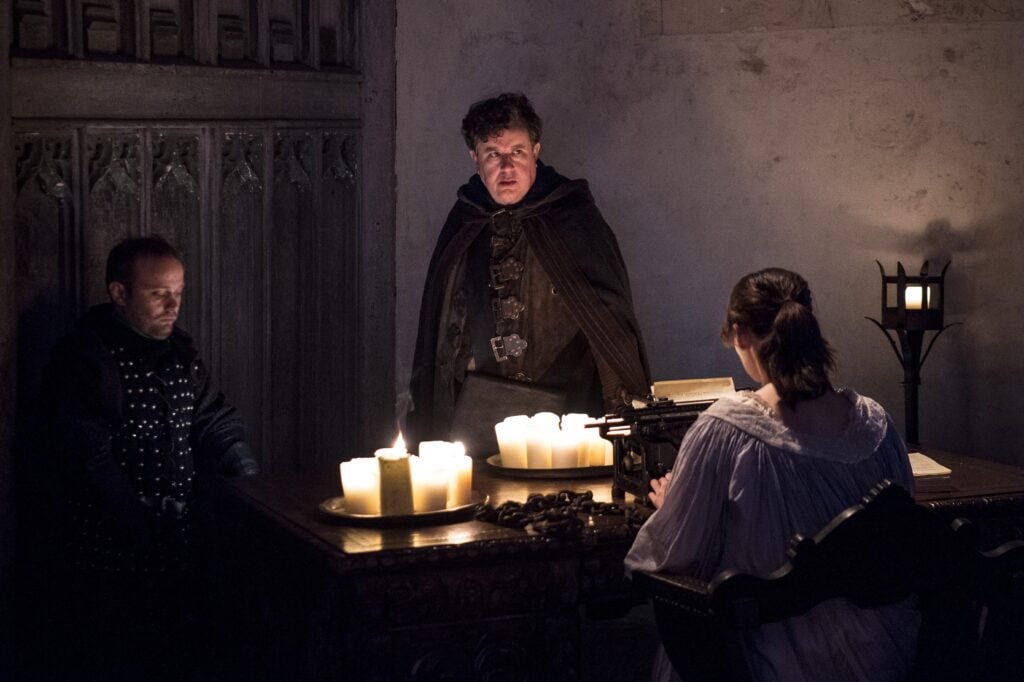Epigraphs in The Silkworm
… blood and vengeance the scene, death the story,
a sword imbrued with blood, the pen that writes,
and the poet a terrible buskined tragical fellow,
with a wreath about his head of burning match instead of bays.
– The Noble Spanish Soldier, Thomas Dekker
‘I met Michael, she said slowly, ‘in a tutorial group studying Jacobean revenge tragedies. Let’s just say it was his natural milieu. He adores those writers; their sadism and their lust for vengeance… rape and cannibalism, poisoned skeletons dressed up as women….. sadistic retribution is Michael’s obsession.’
The Silkworm, Robert Galbraith
The epigraphs in The Silkworm are drawn from twenty-one plays written between around 1587 (The Spanish Tragedy by Thomas Kyd) and 1700 (The Way of the World by William Congreve), so they span a particularly rich century of English drama on and off the stage. They include Jacobean revenge tragedies such as The Revenger’s Tragedy, or The Duchess of Malfi, but also rarities written when Elizabeth I was on the throne, like Orlando Furioso by Robert Greene, and witty social satires written after the English Civil War and the Restoration such as Congreve’s Love for Love.
The Noble Spanish Soldier by Thomas Dekker (1622), from which the epigraph for the whole book is drawn, mixes both comedy and murderous tragedy, with comic characters, and several deaths but those are confined to unsympathetic characters. The quote points to the missing writer, Quine, a poet whose end is certainly tragic, and whose work and fate turns out to be gory and violent and bound up with projects of vengeance. The burning matches he wears in the quote are explosive fuses, and Quine’s disappearance does trigger metaphorical explosions among the literary set of which he was part.
The book at the centre of the investigation, Owen Quine’s slanderous manuscript, Bombyx Mori, has many parallels with the drama of the sixteenth century, though as Strike finds as he reads, there is a lot more explicit sex than got on to the stage in seventeenth century London. The names of the characters often reflect their natures, and the natures of the real people on which they are based, like ‘Vainglorious’ or ‘the Tick’ which is also common in the tragedies and comedies from which the epigraphs are drawn. The lead of The Revenger’s Tragedy is called ‘Vindicie’, or the revenger, for example. The lead character of Bombyx Mori, a young writer of genius, is also called Bombyx Mori which is the Latin name for a silkworm. As editor Jerry Waldegrave tells Strike, Quine used the silkworm as a metaphor for the writer, who must go through agonies to get at the good stuff.

One of the plays most often quoted – The White Devil by John Webster – makes extensive use of the image of the silkworm too. The play is a classic revenge tragedy, violent with dark themes, and is also a satire of corruption among the elite. It was not, on its first performance, well received and though Webster praised the actors, he compared the audience to donkeys. Perhaps that would be something Quine, whose second novel, The Balzac Brothers, received terrible reviews, could relate to.
Shakespeare and Marlowe, giants of the early years from which the plays are drawn, are only quoted in one epigraph a piece, and it’s worth noting that the authorship of the works from which both are drawn is problematic. Christopher Marlowe’s Hero and Leander was finished after Marlowe’s death by George Chapman. The authorship of the one play by Shakespeare used as a source for an epigraph, Timon of Athens, is also disputed. Some critics believe it was left unfinished and unpolished when Shakespeare died, while others say they can see another hand in the text, and that it was a collaboration. Authorship is, of course, crucial to the investigation too – for example the identity of the author the parody that drove Michael Fancourt’s first wife, Ellie, to suicide is a key question.
A popular candidate for co-author of Timon of Athens is Thomas Middleton who is now credited as the writer of ‘The Revenger’s Tragedy’. It’s that play which agent Elizabeth Tassel is referring to when she talks of Fancourt’s love of ‘poisoned skeletons’ and Strike thinks of it too while talking the case over with Robin on the way to Devon to interview publisher Daniel Chard. It also, with a quote referencing the silkworm, provides the epigraph for the final chapter where Strike reveals the bitter quest for revenge has led to an unravelling and the downfall of the avenger.
Chapter 1
QUESTION
What dost thou feed on?
ANSWER
Broken sleep.
– Thomas Dekker, The Noble Spanish Soldier
‘It’s six o’clock in the fucking morning!’
The Silkworm, Robert Galbraith
Like the book as a whole, the first chapter opens with a quote from The Noble Spanish Soldier. There is some doubt about the authorship of this play too. The quote comes from a song, sung as the heroine Onaelia weeps over a crucifix and a defaced image of the king, her faithless lover. The play’s hero, Balthazar is an honest soldier, but unkempt and impatient, and more morally flexible than his virtuous patron, the heartbroken Onaelia.
Strike, another unkempt ex-soldier who can be gruff, and impatient, and who occasionally makes some morally questionable calls, has spent a sleepless night as the investigation opens. He has spent all night with the betrayed lover of a captain of industry rather than a king, and has now woken journalist Dominic Culpepper, to give him the information that will destroy the man’s career. The investigation begins then with the mix of sex, betrayal, corruption and revenge common to much sixteenth century drama. The main effect of the broken night on the investigation of Owen Quine though is that Strike gets involved with the case in the first place. An irritating client and lack of sleep means he impulsively ushers Owen’s wife, Leonora, into his office when she arrives asking for help in tracking her husband down. It also means he doesn’t question Leonora as carefully as he should, and as a result Strike begins the apparently simple search for the missing author without a number of crucial details.
Chapter 6
Oh, Mr Tattle, every thing is safe with you, we know.
– William Congreve, Love for Love
‘I’m just nosy. Wanted to know what’s going on.’
The Silkworm, Robert Galbraith
William Congreve and Ben Jonson, who wrote witty social satires, prove excellent sources for wry commentary in the chapters where Strike and Robin are forced to confront issues in their personal lives, and they also appear when Strike encounters some of the more self-important or flamboyant personalities in the publishing world who knew missing author Owen Quine. One such is Christian Fletcher, the gossipy editor at Crossfire Publishing in Exmouth Market.
Congreve’s play is a light comedy of manners full of wit and wordplay where many of the characters have names that describe their characters, like ‘Scandal’, ‘Tattle’ and there is even a character who thinks he is an astrologer named Mr Foresight.
Strike is annoyed he must visit Fletcher, when it seems a simple phone call would do, but he swiftly realises during the conversation that the disappearance of Owen Quine might be more complicated than the writer’s wife believes. In Fletcher’s eagerness to get information out of Strike he gives a lot away, first asking if the detective has been hired by esteemed author Michael Fancourt, or by publisher Daniel Chard. He then tells the detective about Bombyx Mori, Quine’s latest, scandalous and libellous work, which his agent, Liz Tassel sent to Christian Fletcher before reading it herself. Intrigued when Liz asked for the manuscript to be returned, Fletcher spent the weekend reading it and, as Strike later learns, rang up about fifty people and read bits of it over the phone. The book, which slanders and mocks in obscene and violent detail, Fancourt, Chard, Tassel and others, makes Fletcher think that Quine has lost his mind.

Chapter 12
She is a woman of an excellent assurance, and an extraordinary happy wit, and tongue.
– Ben Jonson, Epicoene, or The Silent Woman
For the first time, as far as Strike could tell, she considered what she was about to say before proceeding a little more soberly.
The Silkworm, Robert Galbraith
The Silent Woman is a Ben Jonson comedy also featuring characters whose personalities or jobs are inscribed in their names, such as the gloomy protagonist, Mr Morose, or the barber, Cutbeard. The word which becomes the name of the title character Epicoene, was used in grammar to describe nouns which might denote male or female individuals. In the play, Morose is persuaded to marry the title character, Epicoene, thinking she never speaks, but she does indeed talk after her marriage and is later revealed as a boy. Bombyx Mori features a character of the same name who Strike later discovers is cruelly modelled on a real individual.
In this chapter Strike meets Nina Lascelles, cousin to journalist Dominic Culpepper, who has agreed to take him to the Roper Chard publishing party as he searches for further clues as to the whereabouts of Owen Quine. They meet in Ye Olde Cheshire Cheese, a pub with many literary connections, and Strike discovers Nina is a clever, lively young woman, keen to flirt with him and talk about Quine, the manuscript and the scandal it has already caused at the publishers. She’s no fan of Quine, or his work, but obviously takes a liking to Strike, something he takes advantage of to acquire a copy of the manuscript of Bombyx Mori from the safe of editor Jerry Waldegrave.
Chapter 16
… let not our supper be raw, for you shall have blood enough, your belly full.
– Thomas Dekker and Thomas Middleton,
The Honest Whore
Strike felt that he stood retching in a temple, witness to sacrificial slaughter, to an act of unholy desecration.
The Silkworm, Robert Galbraith
Though the plot involves poisonings, faked death, gaslighting and madness The Honest Whore is in fact a comedy and ends happily for all, including the Bellafront, the Honest Whore of the title. This is the moment in the investigation however, when Strike discovers that Quine’s story has ended very unhappily indeed, in a particularly foul and gruesome scene. After taking Nina to his birthday dinner at his sister’s house, and spending the night with her, he heads to the house in Talgarth Road co-owned by the writer friends turned enemies, Quine and Fancourt. There, in what was once an artist’s studio, he finds the mutilated remains of Owen Quine – the horrific scene theatrically staged for maximum effect.
Chapter 24
All well bred persons lie – Besides, you are a woman; you must never speak what you think…
– William Congreve, Love for Love
‘I can’t wait to be a step-mummy!’ trills Charlotte…
The Silkworm, Robert Galbraith
While the investigation into Quine’s murder continues, Strike discovers from Helly Anstis, wife of policeman, Richard Anstis, that his former fiancée Charlotte Campbell will soon be married to Jago Ross. He reads an interview Charlotte and Jago give to Tatler and realises the lies Charlotte says about her relationship with Strike, with Ross, her own family and even her attitude to children are all designed to hurt and provoke him. Charlotte is a blue-blooded woman already and now is marrying the future Viscount of Croy so is well bred enough to lie with ease, as the epigraph supplied by Congreve suggests.
The epigraph also touches on Robin’s situation. She is struggling to express herself, hurt by Strike saying they need help at the agency when she is hoping to become more involved with investigative work, but also having to work hard to placate her fiancé, Matthew. Strike throws himself into work after reading the interview with Charlotte, but Robin is stung by his manner into resentful silence.
Chapter 30
… as an earnest of friendship and confidence, I’ll acquaint you with a design that I have. To tell truth, and speak openly one to another…
– William Congreve, Love for Love
‘You’ve got a lot of aptitude for the job, said Strike, ‘but you’re getting married to someone who hates you doing it?
The Silkworm, Robert Galbraith
Robin opened her mouth and closed it again.
Congreve provides another fitting epigraph as Robin’s frustrations come to a head. Robin saves their lives with her driving skills on the way to Devon, but is excluded from the interview with publisher Daniel Chard when they arrive at his unusual home near Tiverton.
After the interview she explodes angrily over burgers at Tiverton Services, and though Strike listens, and says how much he values her, he also confronts her with the truth that marriage to Matthew is going to make pursuing her vocation for investigative work very difficult. Robin is beginning to realise if she is going to carry on doing the job she loves, she’ll have to have an open conversation with Matthew too.
Chapter 39
I am so well acquainted with despair, I know not how to hope…
– Thomas Dekker and Thomas Middleton,
The Honest Whore
‘What’s going to happen to Dodo if they keep me in prison?’ she asked him through her sobs. ‘Edna can’t have her for ever. She can’t handle her.
The Silkworm, Robert Galbraith
Leonora is arrested for her husband’s murder, and Ilsa Herbert, Strike’s friend who is acting as her solicitor, arranges for Strike to visit her. Before the visit, he reads an interview with author Michael Fancourt which Robin has found. It has some interesting points for the investigation, and includes some details about his first novel, Bellafront. The title comes from The Honest Whore, which provides the epigraph to the chapter, but though the play is a comedy, Fancourt’s novel is far darker. The interview also mentions he is erecting a sculpture of the Fury Tisiphone, the Greek avenger of murder, in the garden of his Elizabethan manor.
Strike visits the prison, Holloway, where Leonora is being held. She is panicked and confused, desperately worried about her daughter Orlando. Strike remains convinced she is innocent and determined to prove it. As he returns to the centre of town on the bus, passed the Christmas decorations and early revellers, in a dark mood, scowling as he thinks of injustice and murder, and silently repels anyone who might think to sit next to him.
The play Orlando Furioso by Robert Greene is the source for one epigraph in the novel. It’s based on an epic Italian poem and the Orlando in question is a male knight who has lost his wits after. Orlando in the Silkworm is Leonora and Owen’s disabled daughter who forms a particular bond with Robin. The poem was a key inspiration of The Faerie Queene by Edmund Spencer which provides all the epigraphs in Troubled Blood.

Chapter 43
Hoy-day, what a sweep of vanity comes this way!
– William Shakespeare, Timon of Athens
‘He’s got ideas,’ said Strike. ‘Meanwhile Waldegrave thinks the Cutter’s really an attack on you!
The Silkworm, Robert Galbraith
‘But I’m Vainglorious,’ said Fancourt with a smile. ‘Everyone knows that.’
Strike gets to meet the great novelist, Michael Fancourt, as opposed to seeing him across a crowded room at the Roper Chard party, only late in the investigation. The feted author agrees to meet him at the Groucho Club; a haunt of the sort of actors and artists Timon of Athens ends up believing to be parasites. Strike, a real soldier, is notably distracted by an actor who recently played one talking about himself to two other men nearby. Even Fancourt’s assertion he is ‘Vainglorious’ in Owen’s manuscript comes with a tinge of self-regard. Fancourt’s account of his friendship with Owen, and their friend Joe, and their agent Elizabeth is acid and full of self-regard.
As Strike leaves, Fancourt waves away his attempt to pay with a patronising quote from Ben Jonson, and is flattened when Strike replies with Catullus, a bitter lyric about friendship betrayed (seventy-seven). Strike’s translation involves acid eating up the poet’s insides – particularly appropriate given Quine’s grisly end.
Fancourt’s quote comes from Ben Jonson’s Every Man in His Humour, a comedy which provides five of the books’ epigraphs. Brainworm, the character Fancourt is comparing Strike to in a patronising way, in the play, uses his wit to expose the hypocrites of his supposed betters, though his methods are a lot more morally dubious than Strike’s dogged pursuit of the truth.
Timon of Athens, which was published in the first folio of Shakespeare’s works though the authorship is disputed, follows Timon, a generous Athenian, as he feasts with his friends, including artists and poets. They later spurn him when he is in need, he hosts another feast where he feeds them stones, so feasts form key scenes in the play, just as one particularly unpleasant one ends Bombyx Mori. Timon leaves the city and discovers a new fortune, but this time he uses it to spread rebellion and disease, destroying the city he has come, in his bitterness, to hate.
Chapter 47
Does the silkworm expend her yellow labours
For thee? For thee does she undo herself?
– Thomas Middleton, The Revenger’s Tragedy
One big explosion of malice and obscenity, revenging yourself on everyone.
The Silkworm, Robert Galbraith
The Revenger’s Tragedy is probably the best-known Jacobean revenge tragedy of them all. It’s violent, cynical, so dark it’s often played as a black comedy now, beginning with a man cradling the skull of his dead beloved, and indeed involving a poisoned skeleton dressed up to seduce a corrupt Duke.
As heavy snow falls at the Chelsea Arts Club, Strike confronts Quine’s killer with the evidence of another plot full of hidden desires and baroque revenge which has deep literary resonance. The police may have focussed on Leonora but Strike’s facility for reading people, dark motivations and complex texts like Bombyx Mori, mean that it is he who finds the real killer and the twisted plot they have spun.




